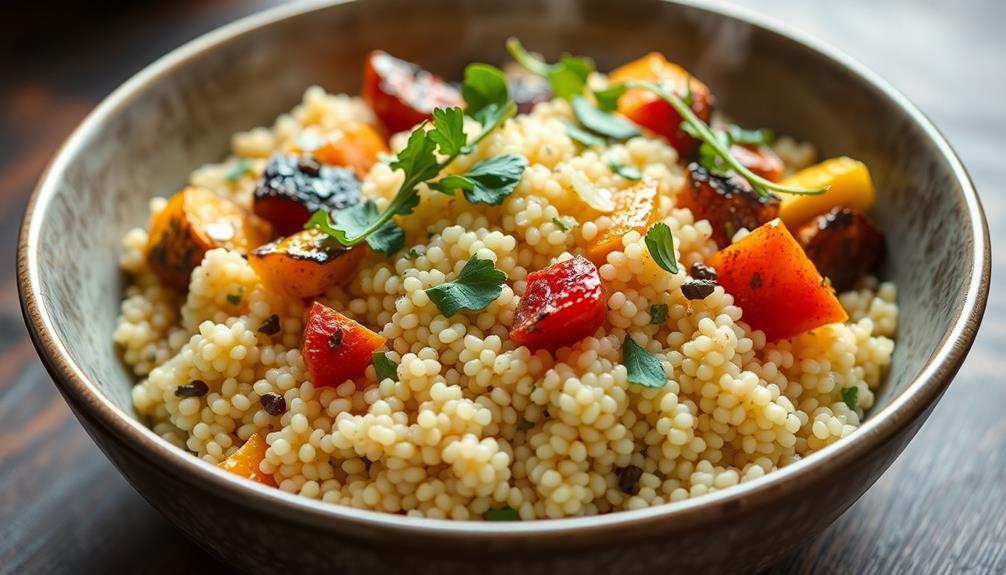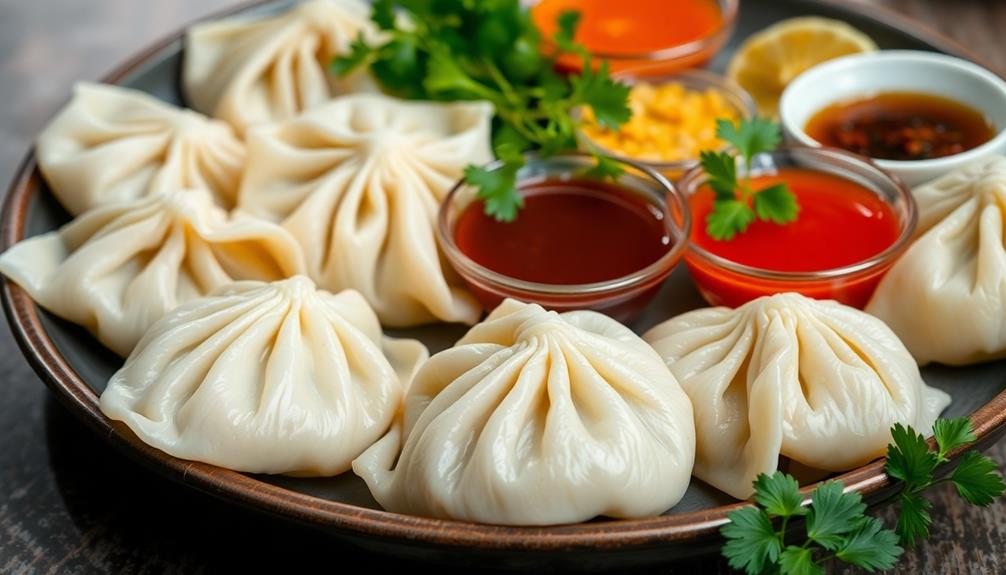Rinsing quinoa first removes any bitterness, then cook it with a 2:1 water-to-quinoa ratio for fluffy perfection. After simmering, fluff it with a fork and let it sit for 5 minutes. Now, you can customize it – add veggies, proteins, or herbs for endless flavor combinations. Quinoa's versatility makes it perfect for every meal, from porridge to salad to stir-fry. Whether you enjoy it warm or chilled, this ancient superfood offers impressive nutrition and endless possibilities to explore.
Key Takeaways
- Rinse quinoa under running water to remove the natural bitterness before cooking.
- Use a 2:1 ratio of water to quinoa and cook until the water is absorbed and the grains are fluffy.
- Fluff the cooked quinoa with a fork to separate the grains for a light, airy texture.
- Experiment with cooking quinoa in broth instead of water to infuse it with more flavor.
- Customize quinoa dishes by mixing in vegetables, proteins, herbs, and seasonings to suit your taste preferences.
History

Quinoa's ancient roots can be traced back to the Andean region of South America, where it has been a dietary staple for over 5,000 years.
This versatile grain, often mistaken for a seed, was a sacred food for the Incas, who referred to it as "the mother grain."
Quinoa's resilience and adaptability allowed it to thrive in the challenging Andean climate, making it a reliable crop for the indigenous communities.
Over time, quinoa has gained global popularity, becoming a beloved ingredient in kitchens around the world.
Its remarkable nutritional profile, which includes high-quality protein, fiber, and a variety of vitamins and minerals, has contributed to its rise in popularity as a health-conscious superfood.
Today, quinoa is cultivated in many parts of the world, but its roots remain firmly planted in the vibrant culinary traditions of the Andes.
Recipe

Quinoa is a superfood that has become increasingly popular in recent years. It's packed with protein, fiber, and a variety of essential vitamins and minerals. Cooking quinoa is quick and easy, making it a versatile ingredient for a variety of dishes.
To cook quinoa, you'll need to first rinse it under running water to remove the saponin, a naturally occurring compound that can give the grain a bitter taste. This step is important to ensure your quinoa has a pleasant, nutty flavor.
Ingredients:
- 1 cup quinoa
- 2 cups water or vegetable/chicken broth
- 1/4 teaspoon salt (optional)
In a medium saucepan, combine the quinoa, water or broth, and salt (if using). Bring the mixture to a boil over high heat.
Once boiling, reduce the heat to low, cover the pan with a lid, and let the quinoa simmer for 15-20 minutes, or until all the liquid has been absorbed and the quinoa is light and fluffy.
Fluff the cooked quinoa with a fork and let it sit for 5 minutes before serving.
Quinoa can be used in a variety of dishes, from salads and pilafs to breakfast porridges and desserts. For best results, use the cooked quinoa immediately or store it in an airtight container in the refrigerator for up to 5 days.
Cooking Steps

First, rinse the quinoa under running water to remove any bitterness.
Once cooked, fluff the quinoa with a fork to keep it light and fluffy.
Then, you can add your favorite vegetables, proteins, or seasonings to make it a complete meal.
Step 1. Rinse Quinoa to Remove Bitterness
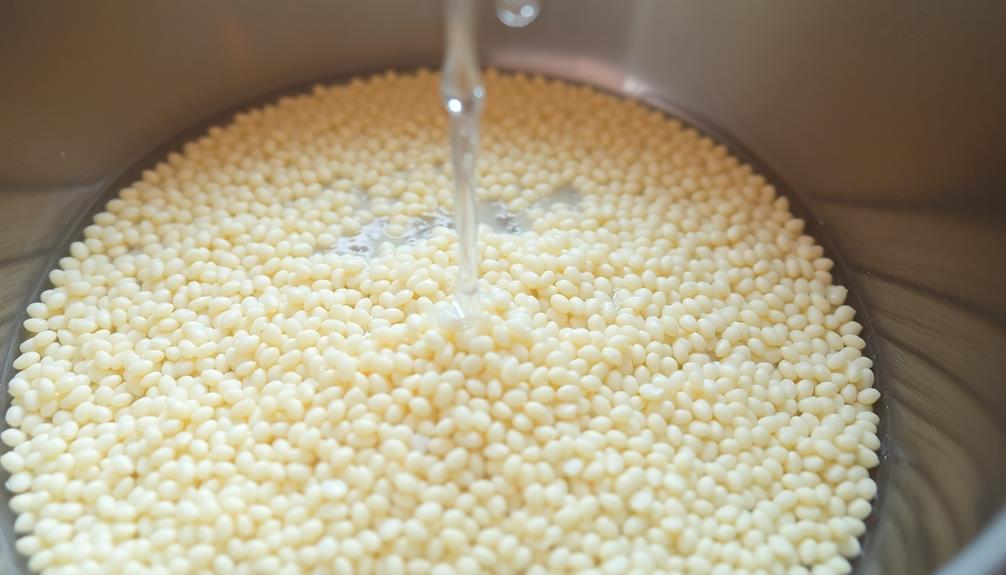
Rinsing the quinoa is a crucial step to remove its natural bitterness. That's because quinoa has a coating called saponin, which can taste unpleasantly soapy. To get rid of this, simply place the quinoa in a fine-mesh strainer and rinse it thoroughly under cool running water.
You'll notice the water turning a bit soapy – that's the saponin being washed away. Be sure to rub the quinoa gently with your fingers as you rinse to dislodge any stubborn bits.
Rinsing usually takes about 30 seconds to a minute. Once the water runs clear, you're good to go! This step ensures your quinoa will have a nice, mild flavor.
Skipping the rinse could result in a bitter, unpalatable dish. So don't forget this important prep work. With just a quick rinse, you'll unlock quinoa's delicious nutty taste and tender texture.
Step 2. Fluff Quinoa With Fork

Once you've rinsed the quinoa, it's time to start cooking. Grab a fork and get ready to fluff that quinoa! This simple step is crucial for achieving the perfect fluffy texture.
First, transfer the rinsed quinoa to a medium saucepan. Add the recommended amount of water or broth, then bring the mixture to a boil over high heat.
Once it's boiling, reduce the heat to low, cover the pan, and let it simmer for around 15-20 minutes. Don't lift the lid during this time – you want to keep all that steam inside!
When the time's up, remove the pan from the heat. Uncover it and grab your trusty fork. Gently fluff the quinoa by running the fork through it, lifting and separating the grains.
This simple motion helps to break up any clumps and ensures the quinoa has a light, airy texture. Fluff it until you're satisfied with the results, then serve it up and enjoy your perfectly cooked quinoa!
Step 3. Add Vegetables/Protein
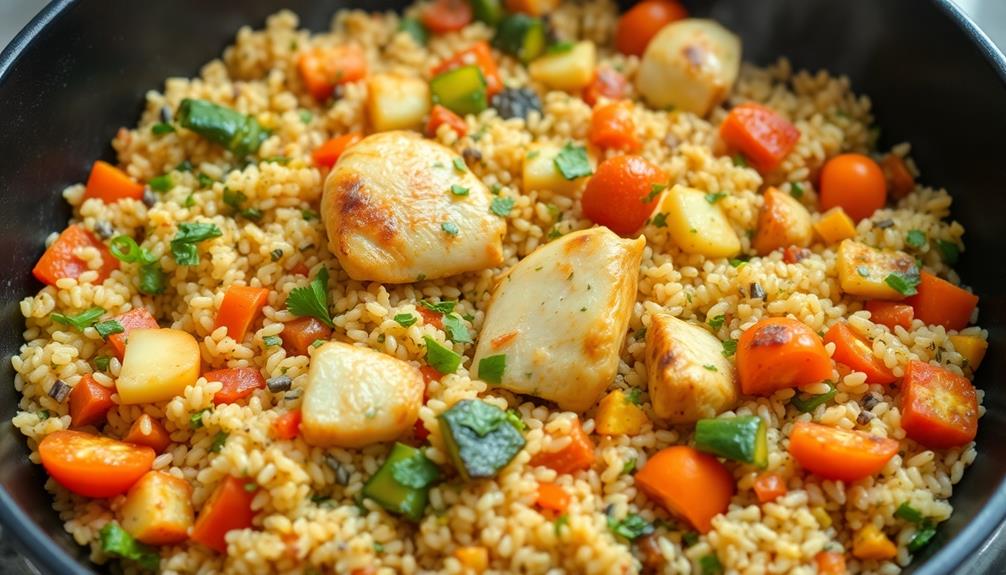
After fluffing the quinoa, you can proceed to add your desired vegetables and/or protein. This is where you can really make the dish your own!
Start by chopping up your favorite veggies – maybe some colorful bell peppers, zucchini, or cherry tomatoes. Toss them right into the fluffy quinoa.
If you want to add a protein, grilled chicken, sautéed shrimp, or even roasted chickpeas would all be delicious options. Just make sure to cook the protein separately before mixing it in. This will help it retain its texture and flavor.
Feel free to get creative with seasonings too – a sprinkle of garlic powder, a squeeze of lemon, or a dash of Italian herbs can take your quinoa to the next level.
The key is to have fun and experiment with different ingredient combinations until you find your perfect quinoa creation.
Get ready to impress your friends and family with your quinoa cooking skills!
Step 4. Season With Herbs
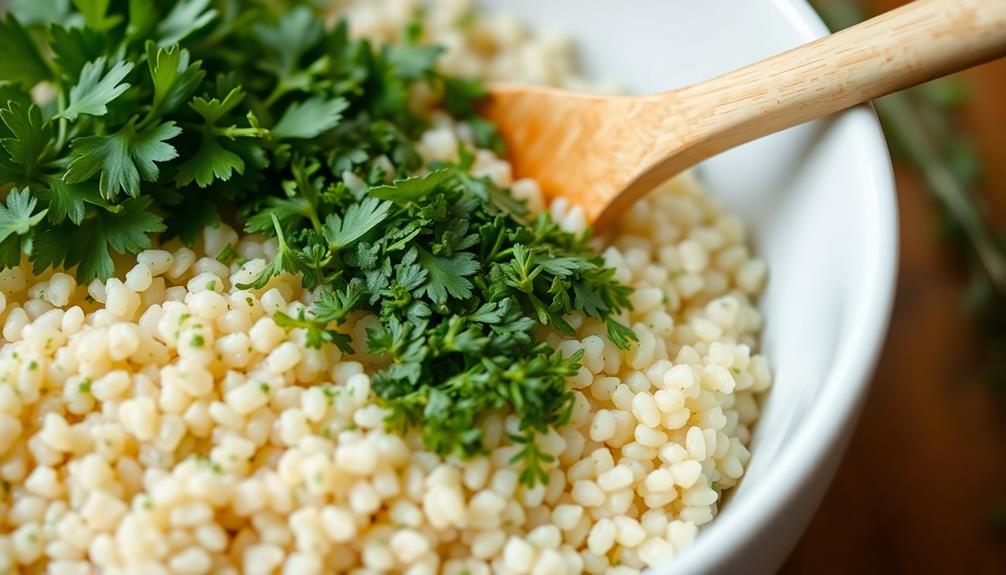
Seasoning your quinoa with fresh herbs can truly elevate the dish. Once your quinoa is cooked, take a moment to add a sprinkle of your favorite herbs. Cilantro, parsley, and chives are all excellent options that will infuse your quinoa with bright, bold flavors.
The use of herbs can also enhance relaxation and stress relief, much like the benefits of aromatherapy in daily life emotional aromatherapy wheels assist in identifying mood-enhancing oils.
Start with just a tablespoon or two of chopped herbs per serving of quinoa. You can always add more if you want an even stronger herbal note. Gently fold the herbs into the quinoa, making sure they're evenly distributed. The warmth of the just-cooked quinoa will help release the herbs' essential oils, filling your kitchen with an appetizing aroma.
For an extra pop of flavor, consider adding a squeeze of lemon or lime juice over the top. The citrus will complement the herbs beautifully and balance out the quinoa's nutty taste.
Fluff with a fork and you're ready to enjoy your perfectly seasoned quinoa creation.
Step 5. Serve Quinoa Warm or Chilled
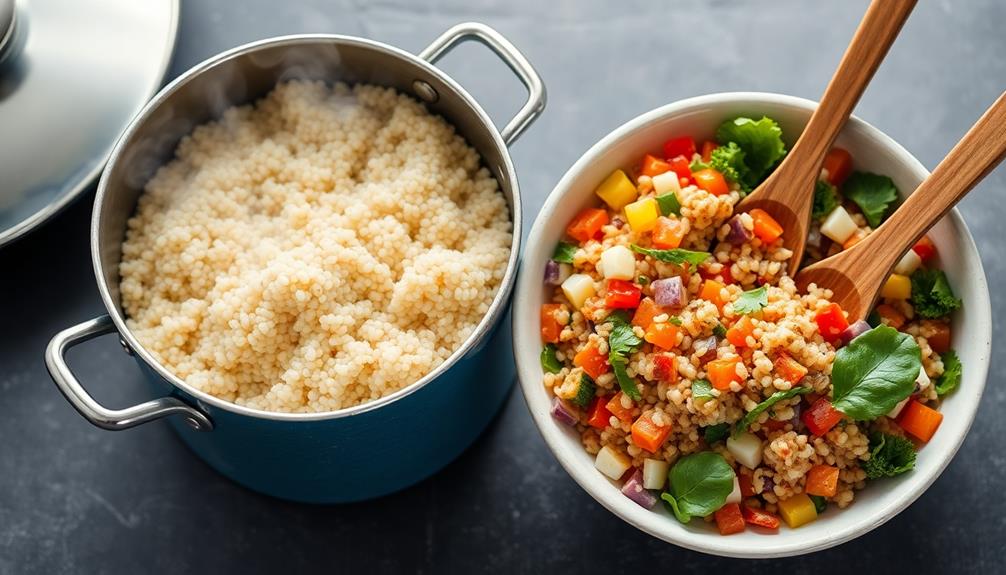
With your quinoa now infused with the vibrant flavors of fresh herbs, it's time to decide how you'd like to serve it. You can enjoy the quinoa warm, which is perfect for a comforting meal, or you can chill it for a refreshing salad.
To serve the quinoa warm, simply scoop it directly from the pot onto your plate. The heat will help the flavors mingle and create a satisfying, wholesome dish.
If you prefer a chilled quinoa, spread it out on a baking sheet and let it cool completely in the refrigerator. Once chilled, you can toss it with your favorite vegetables, nuts, or a light dressing for a delightful salad.
Whichever way you choose to serve your quinoa, you'll be able to savor the depth of flavor from the herbs. The versatility of quinoa allows you to adapt it to your mood and the occasion, ensuring you can enjoy this nutritious grain any time, any way.
Final Thoughts

Quinoa's versatility and nutritional profile make it a worthwhile staple in any kitchen. Whether you prefer it warm or chilled, quinoa can be the star of your meal or a wholesome side dish. Get creative by experimenting with different flavor combinations – the possibilities are endless!
As you continue exploring this superfood, remember that the key is to find what works best for your tastes and dietary needs. Don't be afraid to adjust cooking times or tweak seasonings to suit your preferences. Quinoa's quick prep time and impressive nutrient density make it a smart choice for busy schedules and health-conscious eaters alike.
With its mild, nutty flavor and fluffy texture, quinoa is a versatile grain that can enhance both savory and sweet dishes. Whether you're new to quinoa or a seasoned pro, approach each recipe with an open mind and a willingness to discover new ways to enjoy this superfood.
The more you experiment, the more you'll appreciate quinoa's unique appeal.
Frequently Asked Questions
Is Quinoa a Type of Grain or a Seed?
You may be surprised to learn that quinoa is actually a seed, not a grain. Despite its grain-like appearance and culinary uses, quinoa originates from the Chenopodium plant and is classified as a pseudocereal. Its unique nutritional profile sets it apart from traditional grains.
How Long Can Cooked Quinoa Be Stored?
Cooked quinoa can be stored for up to 5 days in the refrigerator. Simply place it in an airtight container and it'll stay fresh and ready to use in your next meal. Enjoy its versatility!
What Are the Health Benefits of Quinoa?
Quinoa is packed with nutrients! It's a great source of protein, fiber, and essential vitamins and minerals. Plus, it's gluten-free, making it a healthy choice for those following a gluten-free diet. You'll love its nutty flavor and versatility.
Can Quinoa Be Consumed by People With Gluten Allergies?
Yes, quinoa is a gluten-free grain, so it's a great option for people with gluten allergies or sensitivities. You can enjoy quinoa in your meals without worry about triggering any adverse reactions.
How Do I Know When Quinoa Is Cooked Properly?
You'll know quinoa is cooked properly when it's light and fluffy, with a translucent outer shell and a slightly opaque center. Look for the telltale spiral-shaped germ that curls around the grain, indicating it's ready to eat.

